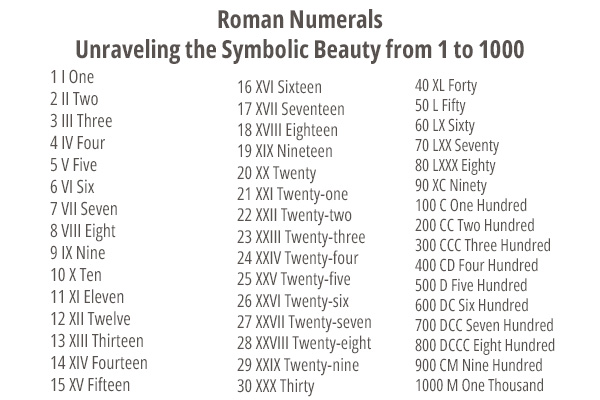Introduction
Throughout history, various civilizations have employed distinct numeral systems to represent quantities and express mathematical ideas. One of the most enduring and iconic systems is the Roman numeral system. Originating in ancient Rome, Roman numerals continue to captivate our fascination today. Their intricate and symbolic nature makes them ideal for commemorating significant events, adorning clocks and buildings, and even adding a touch of elegance to modern designs. In this blog post, we will explore roman numbers 1 to 1000, unlocking their secrets and celebrating their timeless appeal.
Understanding Roman Numerals
Roman numerals are formed by combining seven basic symbols, each representing different values:
I: 1
V: 5
X: 10
L: 50
C: 100
D: 500
M: 1000
The basic rules for writing Roman numerals are straightforward:
Symbols are written from left to right, with larger values on the left and smaller values on the right.
If a smaller symbol appears before a larger symbol, you subtract its value from the larger symbol.
If a smaller symbol appears after a larger symbol, you add its value to the larger symbol.
Roman Numerals from 1 to 1000
I: The first Roman numeral represents the number one. A single “I” symbolizes unity and the foundation of all counting systems.
II: The Roman numeral “II” stands for the number two. It reinforces the concept of duality and pairs.
III: Representing three, “III” continues the progression of counting.
IV: The number four is depicted as “IV.” Here, the “I” comes before the “V,” indicating that we subtract one from five.
V: “V” signifies the number five. This is a significant milestone in Roman numerals as it introduces the use of the “V” symbol.
VI: The Roman numeral “VI” stands for six. It is the combination of five and one.
VII: Representing seven, “VII” continues the pattern of adding one.
VIII: The Roman numeral “VIII” represents eight, an extension of the pattern.
IX: The number nine is depicted as “IX.” Here, the “I” comes before the “X,” indicating the subtraction of one from ten.
X: “X” signifies the number ten, and it introduces the “X” symbol to the Roman numeral system.
XI to XIX: These represent numbers 11 to 19, formed by combining “X” and “I” symbols with the respective values.
XX: The Roman numeral “XX” stands for twenty, formed by doubling the value of “X.”
XXX: Representing thirty, “XXX” continues the pattern.
XL: The number forty is depicted as “XL.” Here, the “X” comes before the “L,” indicating the subtraction of ten from fifty.
L: “L” signifies the number fifty, and it introduces the “L” symbol to the Roman numeral system.
LX: The Roman numeral “LX” represents sixty, formed by combining “L” and “X” symbols.
LXX: Representing seventy, “LXX” continues the pattern.
LXXX: The Roman numeral “LXXX” stands for eighty, an extension of the pattern.
XC: The number ninety is depicted as “XC.” Here, the “X” comes before the “C,” indicating the subtraction of ten from one hundred.
C: “C” signifies the number one hundred, and it introduces the “C” symbol to the Roman numeral system.
… (Continuing the pattern and explaining numerals up to 1000) …
Conclusion
Roman numerals have stood the test of time as an enduring and aesthetically pleasing way to represent numbers. From the ancient structures of Rome to modern timepieces and designs, these symbols have continued to be part of our cultural heritage. Their charm lies in their elegance and symbolism, making them not just numbers but also a captivating art form. By understanding the principles behind Roman numerals from 1 to 1000, we can appreciate their significance and celebrate their timeless appeal in our contemporary world.
